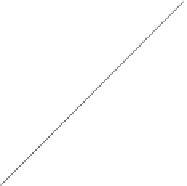Environmental Engineering Reference
In-Depth Information
The PRM is claimed to offer a CPSR of 5:1 with high efficiency of 92-97%
over this range, and power levels of 8 kW and up to 250 kW are said to be possible.
The reluctance torque of the PRM is 1.5 times the permanent magnet torque [22].
At maximum speed, the back-emf of the PRM is 1.3 times the rated voltage, so that
minimal
d
-axis current is needed to perform field weakening. The reason for high
efficiency in the PRM is the fact that field weakening current is only 14% of
maximum inverter current at no load versus 86% in the case of a buried magnet
IPM. This is significant and the reason for the high efficiency noted in Figure 5.29
for the PRM.
5.3.3 Mechanical field weakening
In addition to purely electronic means of field weakening of permanent magnet
machines, there have been, and continue to be, notable mechanical field weakening
designs during the past few decades. This section will discuss two of the more
interesting field weakening schemes. In the first scheme proposed by M. Lei and
others at the Osaka Prefecture University in Japan, a moveable magnetic shunt is
arranged so that as the speed increases, the IPM rotor flux is reduced [23]. The
basic concept is illustrated in Figure 5.30 for the buried magnet IPM design on
which it has been carried out.
(b)
(a)
Figure 5.30 Mechanical field weakening by moving iron shunt: (a) low speed
position of iron shunt and (b) high speed position of iron shunt
The moving iron shunt is in effect a magnetic governor that has a defined
position-speed dependency set by the mechanical design and spring constant (which
can be non-linear). At low speed, the spring is relaxed and the movable iron shunt is
out of the flux bypass cavity. At high speed, the spring compresses due to centrifugal
force, causing the iron shunts to move into the bypass cavities, thereby shunting
magnet flux through the rotor iron bridge instead of allowing it to link the stator.
The benefit of this mechanical field weakening scheme is that the machine
efficiency is improved in the field weakening region, unlike the conventional IPM
for which field weakening efficiency is low due to high
d
-axis currents. Figure 5.31































































